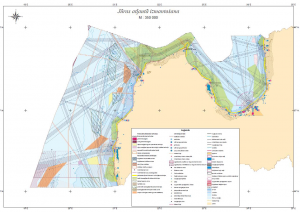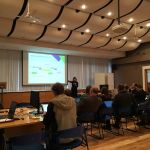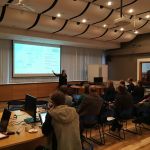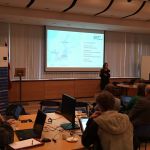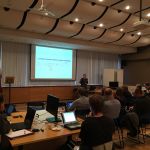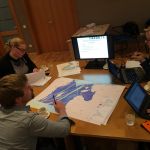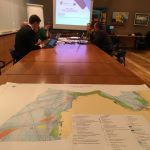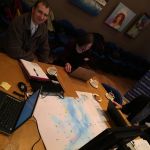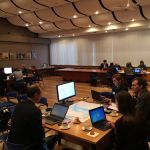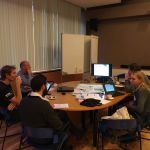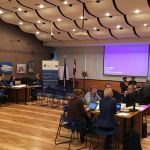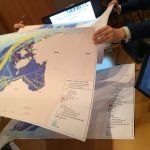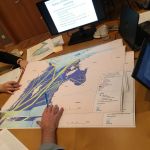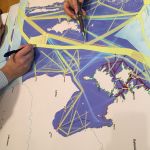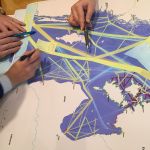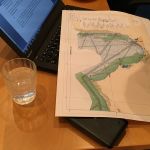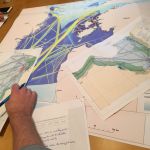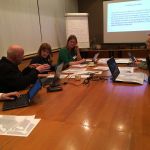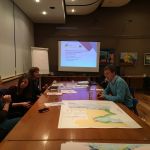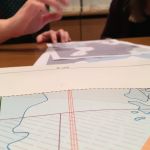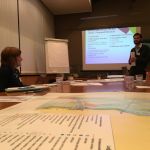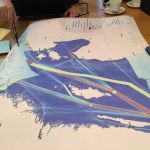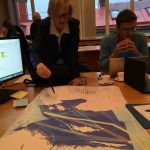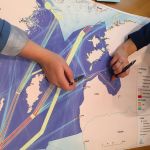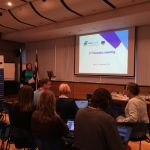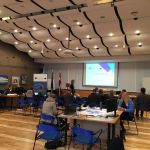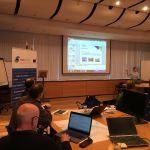The thematic meeting to discuss the priority areas chosen for the Central Baltic case was held on 16-17 December in Riga, Latvia.
The main purpose of the meeting was to meet and go deeper into each priority area – fishery, energy, shipping and environment to continue to develop the topic papers for each of those areas.
At the beginning of the meeting the representatives of the countries involved in the Central Baltic case – Latvia, Estonia and Sweden – presented their current state of affairs regarding the preparation of the Maritime Spatial plans.
Latvia – has prepared the draft of the MSP and will have the second round of national stakeholder consultation in January and February. Cross border consultations with Sweden, Estonia and Lithuania on national MSP according to ESPOO convention procedures will be organised by Latvia at the end of January 2016.
Estonia – has decided to start the official MSP process at the end of the Baltic SCOPE project – at the beginning of 2017. Preparation for national process will be done then via Baltic SCOPE project where outcomes of the thematic discussions will be useful for drafting Terms of reference for Estonian MSP. Some research, bilateral meetings and cross-border cooperation is planned in 2016.
Sweden – is planning on sectorial basis, meaning, separate reports will be prepared and used as planning evidence in later stage. National areas, stated in current status report, are prioritising sectors and goals to manage overlaps between different uses of the sea.
The discussions continued into four groups for each priority area.
The aim of the workshop is to introduce the outcomes of the national meetings; to clarify the national purposes of the project by partners and to discuss the current situation and agree on methodological approach how to describe past and current status of shipping in the project including transboundary issues and future developments.
Estonia had three national stakeholder meetings were agreed on the first principles:
- Shipping has to be free in marine space as much as possible
- There are planned water traffic areas for commericial ships with 1 nm and for small crafts with reserved with 0.5 nm
- In case of navigational shipping route changes it doesn’t require the official change of MSP
The final purpose of the Baltic SCOPE project for Estonia is to create ground for the official MSP starting in 2017.
Latvia has the first draft for MSP and held three consultation rounds since February 2015 discussing 1) reserved zone for shipping which includes 6 nautical miles, taking into account the future perspective when it comes to increase in ship size (2 nm is for the lane and the 2 nm to both sides are safety zones. Some of the bigger shipping lines are not of national interest, because they are transit lines.); 2) existing sea use map which are dynamic – when something changes, the map will change, not having any legal implications.
Sweden has compiled two documents: 1) MSP current status 2014 and 2) Proposal for the Direction of the Marine Spatial Planning and the Scope of the Environmental Assessment. Sweden also had completed the first meeting out of 3-4 between only national authorities in charge of shipping. Discussion focused on global and regional trends of shipping increase. It was eventually agreed that shipping in Sweden probably needs more space. At the same time vessel size in Sweden will increase to some extent, but most probably ships are not going to be bigger in size as the biggest ships navigating already now.
Compiling the overview of the past and present use of shipping the following subgroups could be used:
- cargo traffic,
- passenger traffic,
- (recreational) small craft traffic,
- fishing vessels traffic,
- ports and harbours with its’ hinterland can be seen as the main functional link between sea and land.
Future needs:
There is a need for an overview on the political and strategical development by sectors in stocktaking phase – Environment; Fisheries; Energy; Defence; Shipping and its subthemes.
Procedure description about the process if it is needed to make changes in the existing IMO routes, because these changes are having cross-border impacts
Possible/indicative future developments of different uses and their need for the space related to the shipping:
- Windmill parks
- Fishfarms
- Underwater energy installations
- Protected areas
- Underwater cultural heritage
- Shipping
Potential restrictions for the shipping in future:
- Artificial installations/man made offshore structures
- Windmill parks
- Fishfarms
- Underwater energy installations
- Environmental protection
- Shipping in case of shipping routes change
Transboundary issues:
- Reserved zones for shipping.
- Safe zoning to protect the artificial structure and to guarantee safe shipping
- What influence a potential transfer of ship traffic, on account of environmental reasons or new installations, would have on shipping in border zones and between countries. (LV-EE-SE)
- Recreational small craft traffic routes and their cross-border connection
Irbe strait TSS
The aim of the workshop was to discuss:
- The outcomes of national consultations
- MSP goals and tasks in the context of use of marine space for energy production
- the level of detail in MSP for the energy sector
- confirmed developments vs the more broad interests of the energy sector
- what role can MSP exercise play in national (and also trans-boundary) energy planning
- Current state of affairs and potential further development of off-shore energy facilities and other energy infrastructure objects
- deployment of power production facilities
- deployment of other energy infrastructure objects
The points debated:
- What impact of SE-FI interconnection on EE-SE, EE-LV, SE-LV?;
- What effects choosing one or another interconnection scenario might have on the rest of the potential projects (cable connections and / or deployment of wind farms);
- Transboundary issues:
- Interconnections are clearly a transboundary issue that requires attention during the national MSP debate;
- SE-EE interconnection
- SE-LV
- EE-LV
- Deployment of RES (off-shore wind) in general does not have transboundary character, except for EE off-shore wind deployment near EE-LV border between Pärnu Gulf and Riga Gulf, which might affect nature protection area on the Latvian side of the border. SE could have interest in seeing the solution of EE-LV situation (above). South Baltic Case (SBC) could provide examples of potential approach[es].
- Interconnections are clearly a transboundary issue that requires attention during the national MSP debate;
- Cables per se do not affect, for example, bird life, construction works might have temporary effect on biotopes;
- Cumulative effect of sectoral activities on the environment, fishing (as it also depends on environment) have to be considered when planning energy activities;
- Deployment of off-shore wind can have effect on transmission system [capacity] because of intermittency of production depending on wind: high supply / oversupply and / or undersupply needs balancing capacities, which can impact decision making on energy production (all sorts – RES, fossil);
- Exploration of hydrocarbons in LV waters can represent a transboundary issue (ESPOO Convention) with SE (and potentially EE, LT and perhaps FI also) regarding nature protection. Also hydrocarbons + RES deployment might have cumulative effect on fish and birds and sea mammals;
- Conflicting interests predominantly concern and are handled on the national level, except for EE-LV (see 3d, 5, 6 above) and LV-SE-EE (see 7 above);
- Priorities in the energy industry usually have the following logic (but also need to look at this in the context of ENTSO-E framework)
- Secure supply of energy
- Vulnerability of energy system
- Balancing capacity (portfolio – RES, fossil, net electricity import)
- Land ownership
- Environmental concerns
- Policy planning






